First Nations people were invited to the Vatican in the wake of Native children’s bodies discovered in Canadian Indian Residential Schools. Was a papal apology enough?
Several delegations of Indigenous peoples made their way to the Vatican in Rome to meet the Pope during the week of March 28 to April 1, 2022. There were three groups, specifically, delegations from Canadian First Nations, Metis and Inuit peoples.
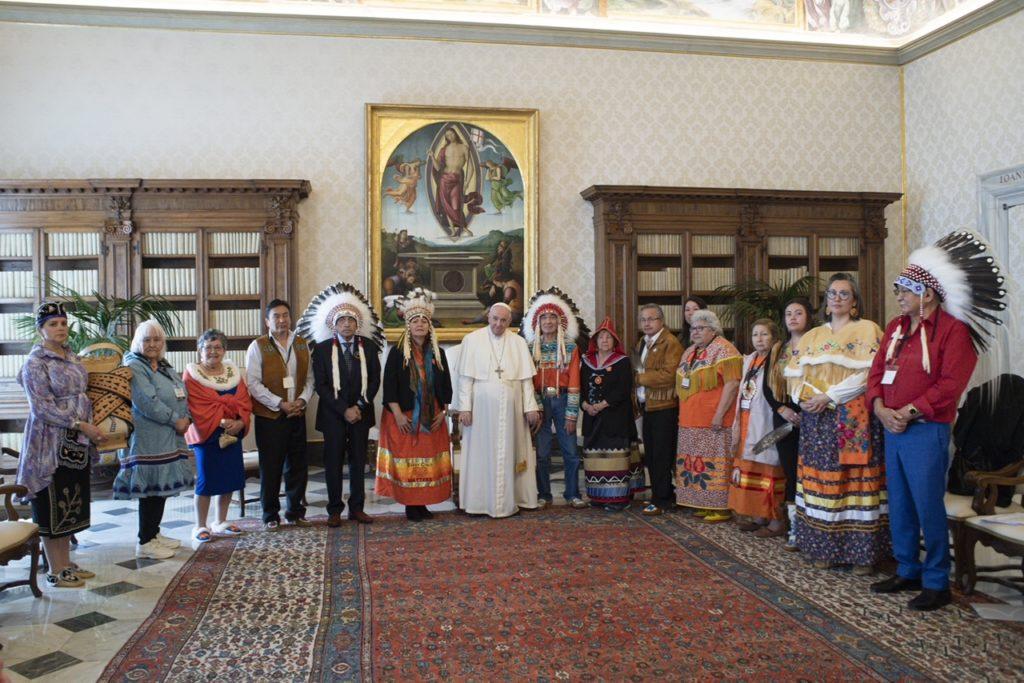
Though there were United States-based Haudenosaunee tribal representatives within the delegations — an official delegation of U.S. tribes was not present, nor invited as part of the Indigenous delegations represented that week.
In a Native Viewpoint interview last week with Mohawk Bear Clan mother Louise McDonald from Akwesasne, Oneida Nation citizen and founder of Rematriation Magazine Michelle Schenandoah, and Mohawk filmmaker and writer Katsitsionni Fox, (also from Akwesasne,) these three powerful women told the story of preparing for a trip to the Vatican, meeting with Catholic officials in Rome, to include the Pope, and the journey and ultimate return of a sacred Haudenosaunee cradleboard given to the Pope to reflect upon.
Mohawk Bear Clan Mother Louise McDonald takes a stand
Mohawk Bear Clan mother Louise McDonald, who is known and referred to affectionately by Haudenosaunee community members as Momma Bear, has long been working to get Canadian government officials — as well as church officials, to take accountability for the historical and cultural genocide committed against Indigenous peoples — whose children were forced into Indian residential schools.
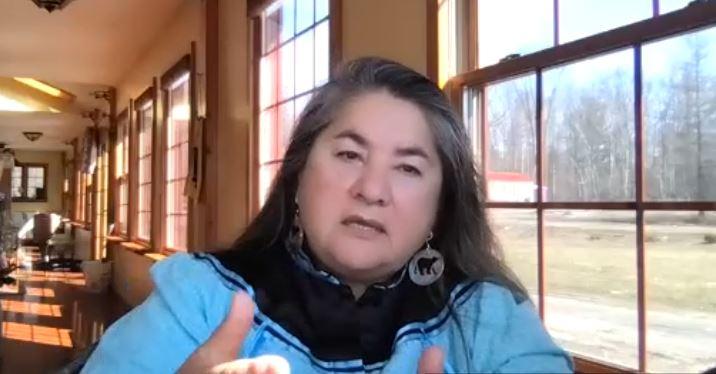
McDonald and other Indigenous leaders including Mohawk Chief Beverly Cook — met with Canadian Minister of Crown-Indigenous Affairs Marc Miller and high-ranking officials of the Catholic Church in the past seeking resolutions to this painful history.
“We presented ourselves and we told them that we wanted accountability,” said McDonald.
“We wanted the church to step forward and own it. And we put a really powerful prayer into the universe about bringing justice (to Indigenous families), and it was a range of emotions to sadness, to anger to who could possibly, in all their thinking, think about harming children. We’re reeling from the residual effects, of not just colonization, but the Indigenous genocide that has occurred on our territories.”
In March of this year, McDonald received a phone call from the Assembly of First Nations secretary Sherry Antonia. “She said, ‘Your name has been put forward to go to Rome and meet the Pope at the Vatican.’”
McDonald said she considered going, but “That’s personally not on my bucket list to do.”
McDonald said there were also vaccination requirements to travel, so she decided to ask community members to go in her place. Michelle Schenandoah was quick to answer McDonald’s request. Katsitsionni Fox also accepted an invitation. “Louise asked me to go with her at first, and later asked if I would go on her behalf,” said Fox. “I was happy when she told me Michelle was willing to go as well. I asked that Michelle be the speaker because she’s a very eloquent speaker.”
That’s personally not on my bucket list to do.
Mohawk Bear Clan Mother Louise McDonald (in response to if she wanted to travel to Rome to meet the Pope.)
“There was a moment that I thought of completely rejecting the invitation and not being part of it,” said McDonald. “But the important thing for me was that this was a very historical moment. In the journey of a lot of Indigenous people, especially the survivors. the world had to know this was an emerging truth. I don’t want my great-grandchildren to look back at me — at this moment and say that I failed to show up when there was a moment to show up.”
“So these young women in their brilliance, and they’re both mothers, they’re both grandmothers, I couldn’t have picked more bulletproof women to go. So away, they went. They jumped on a plane. And the rest is history.”
A text message to meet the Pope
“It’s really quite interesting when you get a text message out of the blue that says, ‘Would you like to go to the Vatican next week to meet the Pope?’” said Michelle Schenandoah of McDonald’s message. This is the kind of thing that maybe (you think) it’s a little bit of a joke, right? How many times do you get a text like that?” asked Schenandoah.
“It was a real honor to have such a request — So I didn’t have any hesitation. I said ‘yes’ because we really do work to support each other. And Momma Bear is somebody who I really admire for her strength and really helping to reclaim and recover all of that silence that was created because of colonization, and who we are becoming as people today.”
Schenandoah realized her passport was about to expire, yet because of the high-level media exposure to the invitation, and with the help of some U.S. senators, her passport was expedited and approved for travel.
As the designated speech giver on behalf of the Haudenosaunee women, Schenandoah considered the message she would deliver to the Pope at the Vatican.
“I started really thinking … What are we going to say? What am I going to say? What will be those words? I really spent a lot of time and reflection and asking for guidance from our ancestors, and from all of those children who were impacted, and those children who never came home.”
Fox and Schenandoah as well as nearly two hundred Indigenous people, were on their way to Rome to meet the Pope.
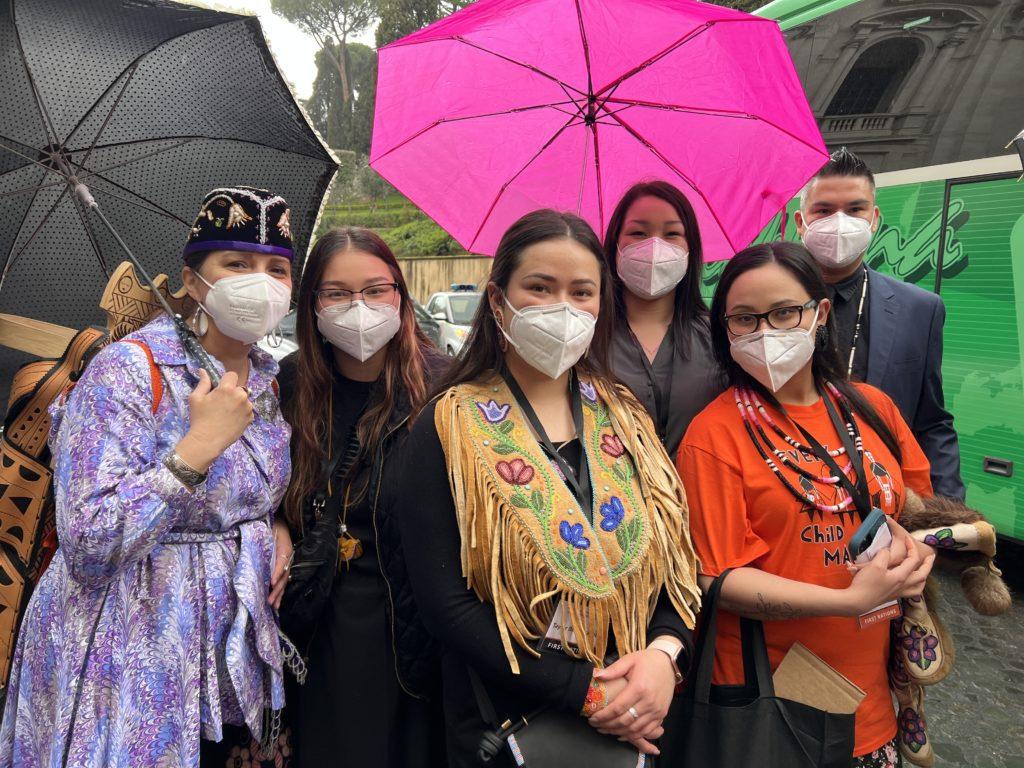
A busy week in Rome
“It was a really jam-packed week,” said Fox, who documented several of the events as well as took photos of the moments at the Vatican. “They had us doing a lot of things. There were a lot of elders that came from all across Canada, that had come to share their stories and to share a message from their communities and from their peoples,” she said.
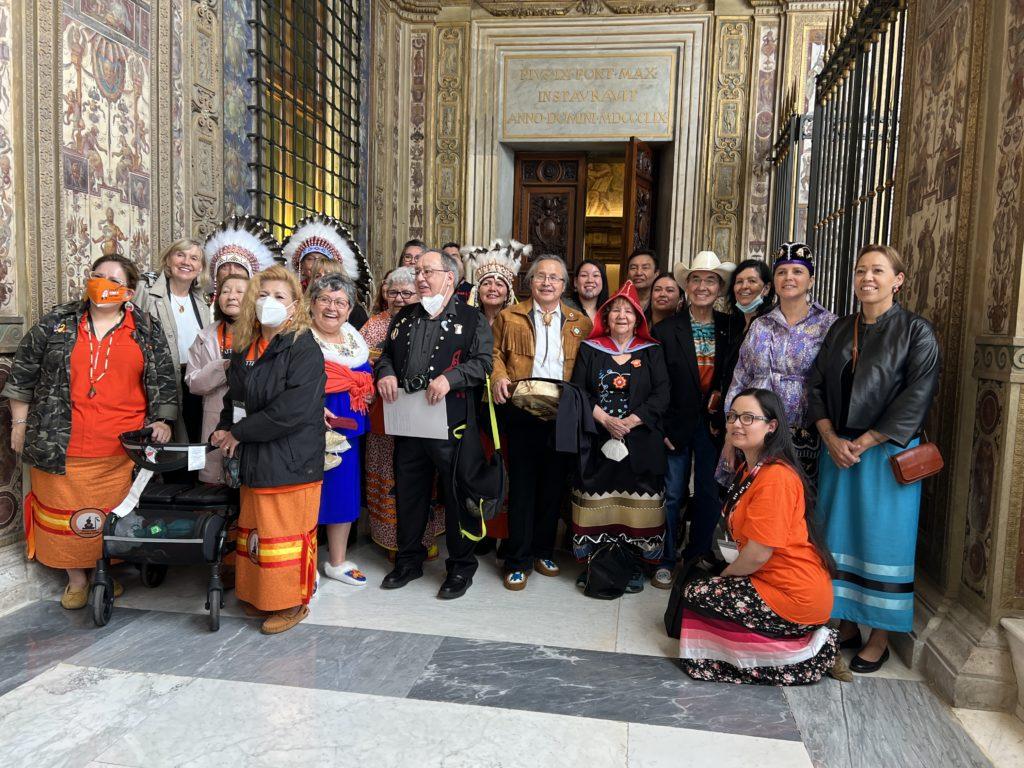
“I was really impressed with all of their courageousness to be there and their bravery, and their commitment to doing that. I was really impressed by the young people that were there, they had two youth delegates on the First Nations delegation … it was encouraging to see that.”
According to Schenandoah, over the course of the week, March 28 to April 1, 2022, there were three delegations. The Metis delegation and the Inuit delegation met the Pope on Monday. The First Nations delegation met the Pope on Thursday, each one having their own private audience.
On the last day, Friday, there was a general assembly of over nearly two hundred Indigenous people meeting the Pope.
During the First Nations delegation meeting with the Pope — a delegation of tribal community members and leaders from the Assembly of First Nations — chiefs, elders and youth delegates shared with the Pope a broad overview of the injustices that have historically occurred against Indigenous peoples. The delegates spoke about the Doctrine of Discovery and elders, who themselves were attendees of residential schools, spoke about the impacts they faced which are still resonating today.
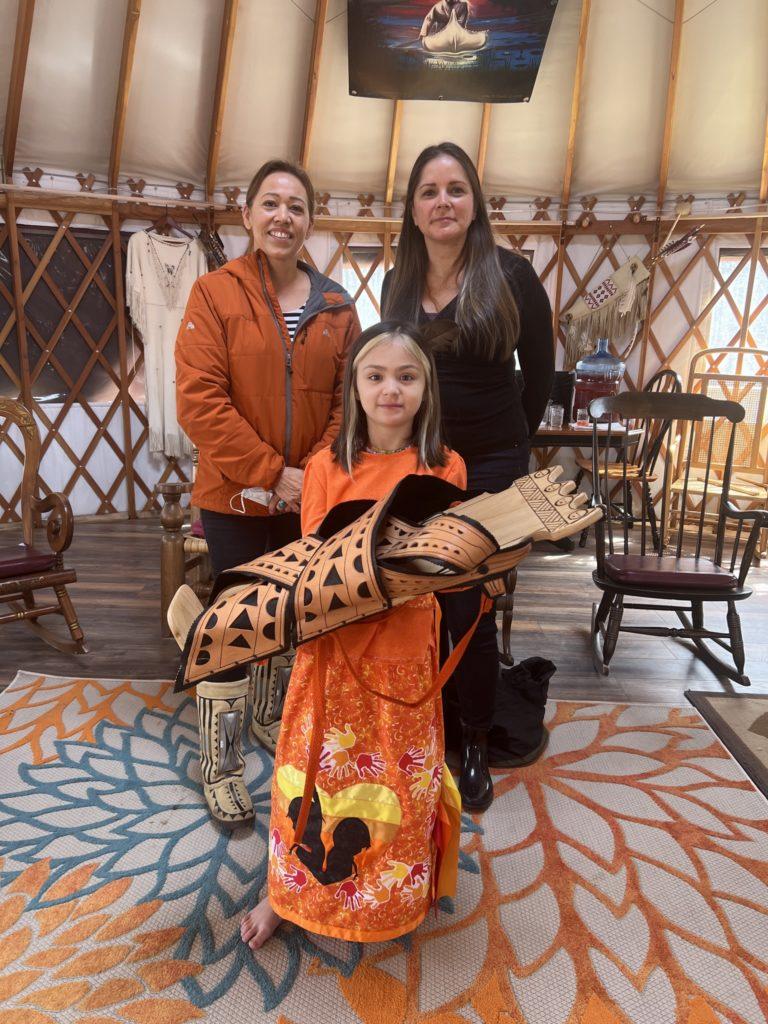
Feeling triggered by the excess of opulence
Fox, who as a filmmaker was working on an exhibition in France regarding her short film titled Wampum, when she was invited by McDonald, said she had little time to prepare mentally and emotionally for the trip to the Vatican.
“When we got there, one of the days we toured the Vatican … By the time we got to the church, I was feeling really triggered and really emotional,” said Fox. When she got back to her hotel room and discussed her experiences with her mother, Fox says she had a strong emotional reaction.
“I was talking about all the opulence … the marble, the gold, the tapestries, the money, you could just see it. It was so evident. (I was) thinking about how they attained all of those things at the expense of Indigenous people all over the world.”
Fox said her emotional strain went even further when Catholic museum officials showed the delegation Indigenous artifacts belonging to the Catholic Church.
“When we went to the Vatican museum, with an Indigenous delegation of different people from all over Canada, they had pulled out different artifacts on these three tables. They had Northwest coast masks, they had small wampum belts, they had war clubs, they had Inuit carvings — they had all these different things that they thought I guess we would like. So we’re seeing these things that belonged to us, and that were made by our ancestors.”
“It was really tough. It was really intense … It was very triggering to be put in that place and to try to keep focused because we had a message to deliver. It was really difficult to experience that. I felt that anger come up and it came out in tears. I think that a lot of our people feel that, and it’s even more intense when you’re actually right there,” shared Fox.
I was talking about all the opulence … the marble, the gold, the tapestries, the money, you could just see it. It was so evident, and in thinking about how they attained all of those things, at the expense of Indigenous people all over the world.
Katsitsionni Fox, Mohawk filmmaker and artist who went to the Vatican in Rome
Confronting the Papal Bull and a cradleboard’s journey
Oneida Nation citizen Michelle Schenandoah went to the Vatican with a sacred item. The item was a baby-sized Haudenosaunee cradleboard.
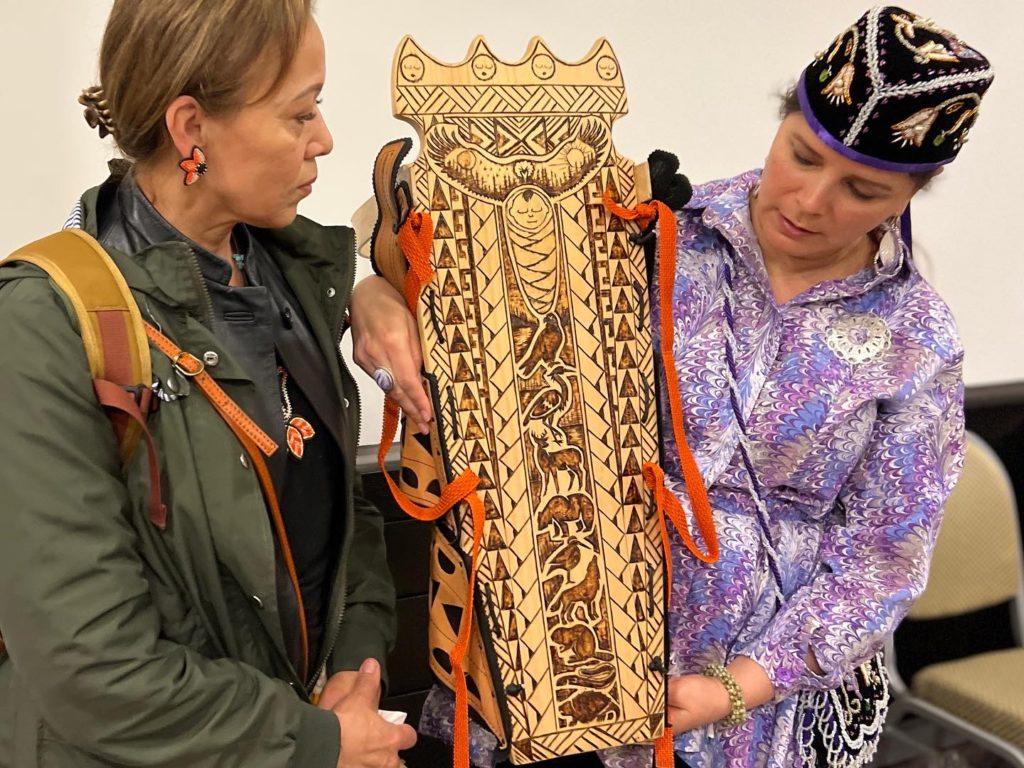
Schenandoah says she was bringing it to the Pope not as a gift, but as an item to be returned after he stayed with the cradleboard over the course of one night. She says the empty cradleboard represented the Indigenous children that never returned home from residential schools.
“Bringing the cradleboard to the Pope was significant, because it gave an opportunity for the Pope, for the entire church, the entire Vatican, for everybody, to reflect upon every single child that ever went to residential boarding schools and all the impact it has had on every single one of our families within our nations,” said Schenandoah.
“That’s the reason it was presented to the Pope — to give him that opportunity to reflect.
“It was an empty cradleboard. It was empty. That cradleboard is what we put our babies in. That’s how we protect and love our children when they come into this world. So for him to have an empty cradleboard that he had to sit with overnight, speaks volumes for generations,” said Schenandoah.
“He was instructed to bring that cradleboard back the next day and that we would be retrieving it and bringing it home. That is symbolic of us bringing our children home to us.”
Songs reverberated when she spoke
When Schenandoah addressed the Pope, she says the voices and songs of the Indigenous people present outside of the room in St. Peter’s Square gave her inspiration to continue.
“During that private audience, as all of our Indigenous relatives were speaking — and what was so interesting — was that for days, it had been raining, and it was gray and overcast. And that day, the rain had let up and the sun had started to come out when we were in that private audience as they were going around and sharing their stories. At one point — all of a sudden — you could hear the singing that was going on out in St. Peter’s Square. You could hear our Indigenous relatives who traveled also to come to be a part of this delegation”
“You could hear the coastal Indigenous brothers that were out there singing with that deep resonance of their voice, just coming through the window because the windows were open. The sunlight had come in and you could just feel the power of everybody’s tobacco burnings and (they were) smoking their pipes and the prayers — you could just feel it in the room. That was just confirmed by the sunshine and the singing and then, you hear the drum … It was just powerful, it was moving.”
“When it came around the time I delivered my speech and delivered the cradleboard. I did let the Pope know as I was handing it over to him that ‘this is for reflection, and I will be back to retrieve this tomorrow.’”
“I made sure that he understood that. His face lit up when he saw me bringing the cradleboard towards him. I wanted to be very clear, ‘this wasn’t a gift.’ This was just only for him to have a point of reflection on how this has impacted all of us as The People and for all those babies who never came home.”
The day all Indigenous representatives met the Pope
The following day, during the general meeting with the Indigenous delegations and the Pope, Schenandoah says she was intent on getting the cradleboard returned.
“What’s really interesting,” said Schenandoah, “is during our final meeting with the Pope in the general audience, the cradleboard was not part of the pomp and circumstance that happened that day. In fact, when I walked into the room in which we were all meeting, I didn’t see the cradleboard. So I approached the Canadian bishops. And I asked them, ‘Does the Pope know that I’m here to retrieve the cradleboard today?’ And they said, ‘Oh, yes, he’s aware, and while it may not be part of the general audience, it will be returned today.’”
At the end of the general meeting, after dancers had performed and the Pope had given olive branches to the delegations, the cradleboard had not yet been returned, which concerned Schenandoah.
“The Pope gave his speech, he gave a gift of an olive branch to each of the three delegations, and got up and said (essentially) ‘Pray for me, because I’ll pray for you. Bye, bye,’ and exited the room. And everybody gets up and starts moving around. And (I thought to myself) ‘where’s the cradleboard?’ I said, ‘I’m not leaving here without it.’”
Schenandoah says that though she did not see the cradleboard, she felt the support of her fellow Haudenosaunee women in getting the cradleboard back.
“There were a number of other Indigenous women who were right there with me in the sense that, ‘We will sit and stay in this room until the cradleboard comes home,” said Schenandoah.
“So, in comes the cradleboard in a shopping bag being held by one of the Canadian bishops, who then meets up with the other Canadian bishops, and I followed them. At that point, he (the Bishop) then had taken it out of the bag and wanted to present it to me, but I wanted to make sure that my sister, Katsitsionni Fox was with me.”
“We were in a sea of 200 people who were all getting up and moving about and getting ready to leave. We were over in a small corner and the Canadian bishops were now addressing me. And so we went forward with it at that moment. As he’s handing it back over to me, he said, ‘The Pope did take the time, and he meditated and prayed with the cradleboard. He requested that when he comes to Canada if we could bring this cradleboard to be with him when he comes back to Canada?’ I said, ‘Sure because then our clan mother who sent this can meet him and share her words with the Pope.’ They seemed okay with that.”
Schenandoah says she realized she needed to take charge of the moment. “I said, ‘You’re willing to meet with our leadership, to talk about the Doctrine of Discovery? The Doctrine of Discovery has to be revoked.’ And they did say they would have those conversations when they returned to Canada.”
She also said that the return of the cradleboard was a significant gesture.
“I reminded him, as I took the cradleboard, ‘This is me bringing our children home.’ I wanted him to know that as he was handing it over, it was not just to me as an individual, but to us as Indigenous people … ‘We’re bringing our children home now.’”
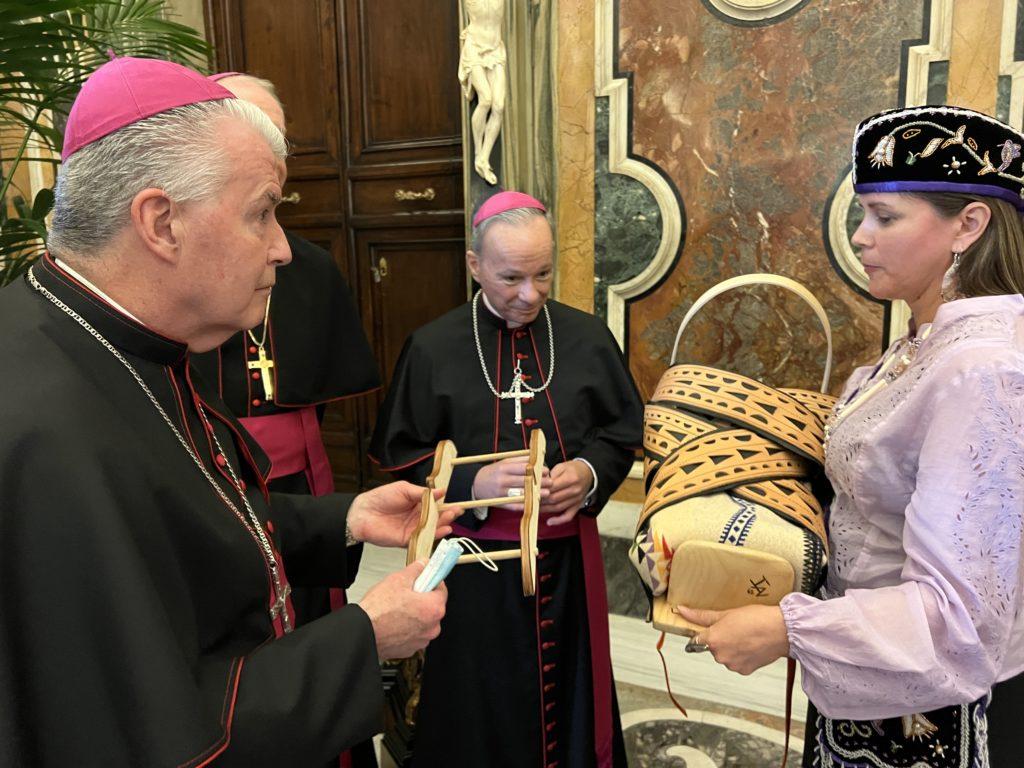
“He went to bless the board and at that moment, I said, ‘Please understand, we have our own ways, you have your ways, and we have ours, and we need to respect that.’ And that’s about the gist of how that return went, but I have to say I pretty much had stayed very steady. And my whole time there, that, for me, was really the toughest moment.”
“I took the cradleboard, we had straps on it, and he (the Bishop) said, ‘Can I help you with that?’ I said, ‘No, it’s okay. We’ve got this. Indigenous women, we’re really strong.’ And I put the cradleboard on my back and left the Vatican at that point.
He went to bless the board and at that moment, I said, ‘Please understand, we have our own ways, you have your ways, and we have ours, and we need to respect that.’ And that’s about the gist of how that return went, but I have to say I pretty much had stayed very steady. And my whole time there, that, for me, was really the toughest moment.
Michelle Schenandoah, Oneida, founder of Rematriation Magazine
A smoke song for healing and a cradleboard returns home
After what Schenandoah described as a difficult moment, she walked with the other women into the square of the Vatican. She says she was relieved as well as encouraged due to music she was familiar with resonating in St. Peter’s Square.
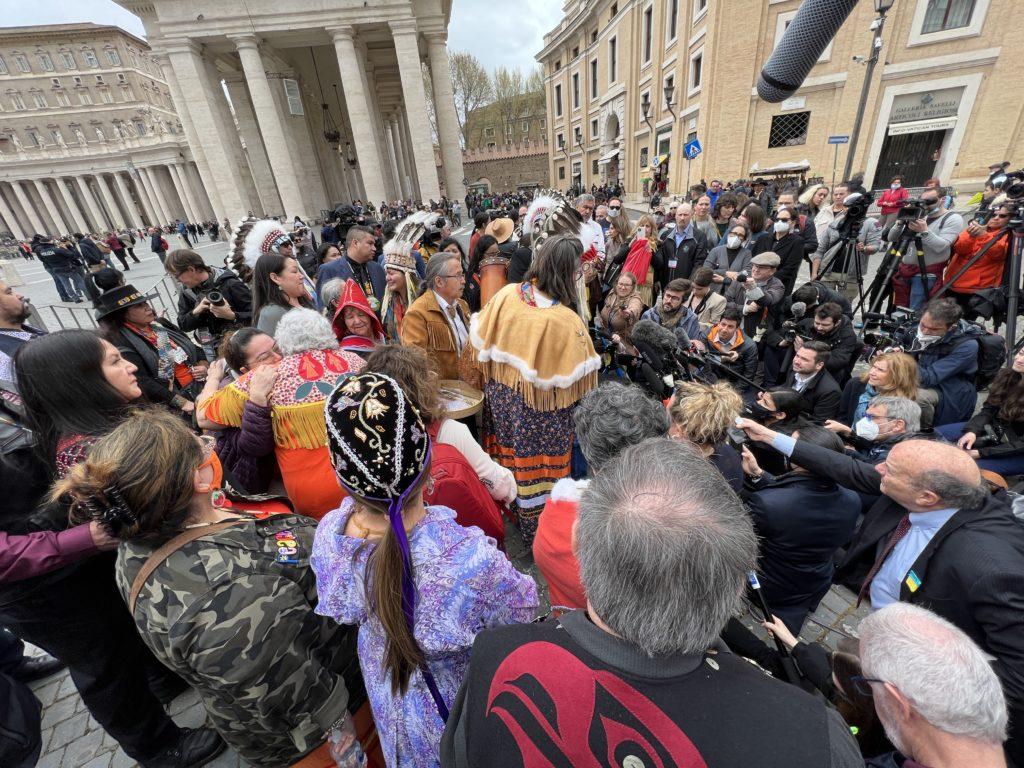
“There was dancing and singing that was out there. I was still having a hard time, coming back to my own center. And next thing I hear, the singers start doing a smoke dance. And I realized, “Oh, we have other Haudenosaunee people here. I thought it was just Katsitsionni and I.”
“There were two singers who were from Six Nations and I went over and they sang me a woman’s dance song. So I danced a woman’s dance in St. Peter’s Square. And for me that was setting out that vibration of our power as who we are as Ukwehuwe, as women, as mothers, and reclaiming who we are, reclaiming our children, and reclaiming … I will say, claiming our future. So that was really important.”
“One of our elders, when we came back, she had mentioned that, when we think about women’s wisdom, it’s a web. When you touch anything on that web, it reverberates. She talked about what we did there was having that web being present. And all of what happened, from the words to the music, to the dance, even the cradleboard, all of it is going to reverberate.”
“It’s just going to continue to reverberate throughout the Vatican, with all of everyone, from the Pope to the Cardinals and the Bishops.”
A cradleboard returns home
Mohawk Bear Clan mother Lousie McDonald said she felt a profound amount of responsibility for sending Schenandoah and Fox into the arms of the oppressor. She reflected on the severity of the impact on Indigenous families whose children were forced to attend residential schools. Many times, the children died due to abuse and neglect.
“It’s a really difficult thing as a mother and as a grandmother to imagine that you gave birth to something so perfect and so beautiful and then somebody scoops it from your arms and then kills it, it’s heart-wrenching. And you can’t imagine the amount of pain that a mother would go through.”
“For me, it was Mothers on a mission because Haudenosaunee people are a matrilineal society, we’re matrifocal. And we know that the entire paradigm of Catholicism and the Christian dominion is very paternal. And so for me to send mothers into the house of the abuser, the one that did all these assaults — to me that was courageous, and we had to send somebody in there who was calm and who could keep focus because I probably totally would have lost it.”
“I was back here the whole week, just burning tobacco every morning and sending my energy to Katsitionni and to Michelle and thinking of them every moment of every day that they were gone, and just praying and hoping that the fact that we sent the cradleboard was going to be enough to invoke some kind of feeling within them,” said McDonald, whose own mother’s mother was forced to attend Shingwauk Residential School in Sioux Sainte Marie, at the age of six, with her little sister, who was only three.
“I was back here the whole week, just burning tobacco every morning and sending my energy to Katsitionni and to Michelle and thinking of them every moment of every day that they were gone…”
Bear Clan mother Louise McDonald
For McDonald, one of the most significant moments was when the cradleboard had come home.
“For me, the most important moment was when Michelle and Katsitsionni (brought it home.) At that moment, when we opened up the suitcase, I swear, it felt like a real baby was in that cradleboard. And then when we pulled back, the blanket was like, (takes a rapid breath in) we lost our breath … that was the moment for me, that just riveted me because I really could feel the spirit and what it was symbolic of, and what it represented.”
“After that initial moment, I started to feel joy and the relief now that the cradleboard can be filled with life, with hope, with regeneration, with the perpetuity of our people vested in our children, which is our most valuable resource. For me, that’s a symbol emblematic of all Indigenous people.”
After a Papal apology, ‘Now is the time for action’
On Friday, April 1, 2022, Pope Francis offered a formal apology to the Indigenous delegations at the Vatican.
He said in part, “I ask for God’s forgiveness and I want to say to you with all of my heart: I am very sorry… I feel shame — sorry and shame — for that role. In the abuses, you suffered and in the lack of respect shown for your identity, your culture and even your spiritual values,” said Pope Francis.
On the same day, there was a similar apology posted on the @Pontifex Twitter account:
“I feel shame for the role that a number of Catholics with educational responsibilities have had in the abuse and lack of respect for the identity, culture and spiritual values of the Indigenous Peoples in Canada. All these things are contrary to the Gospel of Jesus Christ.”
Many Indigenous have taken the apology with a grain of salt and a cautious eye.
Schenandoah offered words of reflection in retrospect.
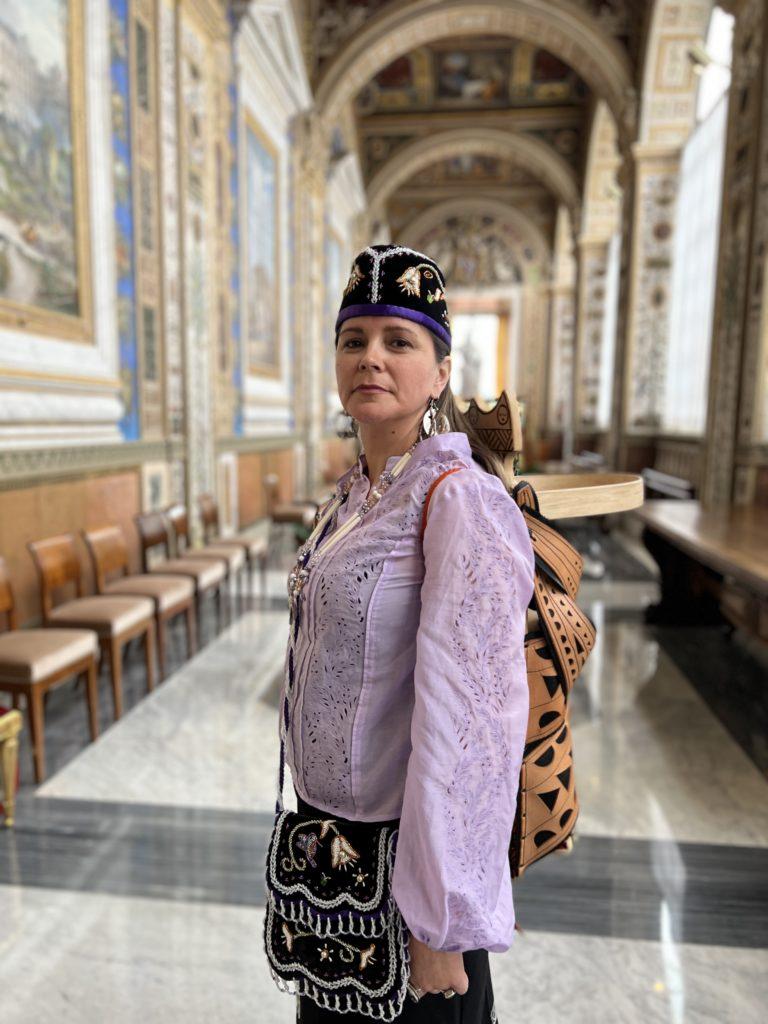
“I think one of the things that I’ve really felt myself and heard from so many people is that it’s action right now. What actions are going to happen?”
“An apology is one thing — and I know that the amount of work that went into making this moment happen has been years in the making — and so many different delegations going in front of the Pope to seek the apology, and the revoking of the Doctrine of Discovery.”
“It’s a step, the door has been opened. But there’s so much more to be done. The next natural step is to revoke that Doctrine of Discovery and not allow any other colonial state anywhere in the world to be able to rely upon this — because it’s been used as a device of genocide for over 500 years against Indigenous peoples.”
“So many of these countries have relied upon this as their basis to hold land in their name, to enslave people, to murder people, to rape people. It still plays itself out today in policy, again, and again and again and again. And it’s going to take the world to open their eyes to see how that actually happens. To say, ‘Okay, we’re not going to accept this anymore. We have to change and now is the time to actually listen to Indigenous peoples because we have a lot of knowledge and wisdom about how to navigate these times.’
“If we don’t, then I don’t know how much of the future we as humankind are going to have together here on this planet. It’s time to change this. The time is now.”
Did you enjoy this story without ads?
Native Viewpoint does not use ads on its website and articles to allow readers the ability to enjoy the story without distractions. If you enjoy reading this and other articles, please support and donate to Native Viewpoint by clicking here.
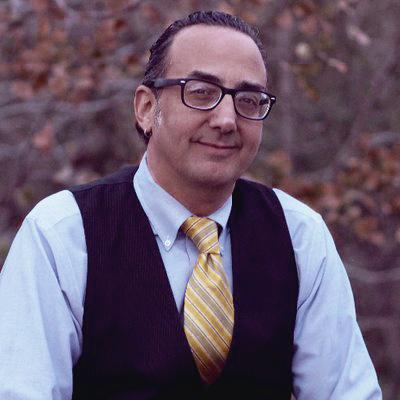
Vincent Schilling, Akwesasne Mohawk, is the founder and editor of Native Viewpoint. With nearly 20 years of experience as a Native journalist and former member of the White House Press Pool, Vincent works to uplift underrepresented voices in the world of media and beyond. Follow Vincent on YouTube.com/VinceSchilling, on Twitter at @VinceSchilling or on any other of his social media accounts by clicking on any of the icons below.
Support Native Viewpoint a Native multimedia website, by clicking here.